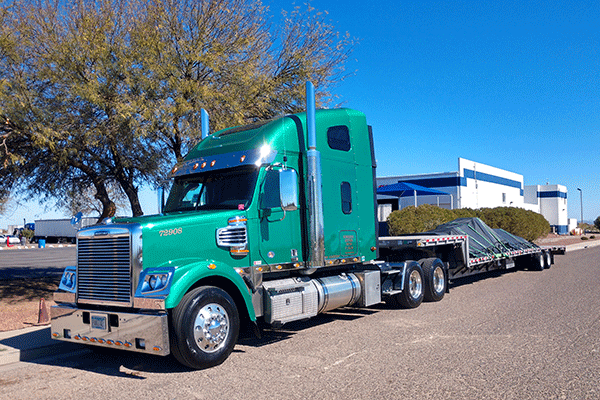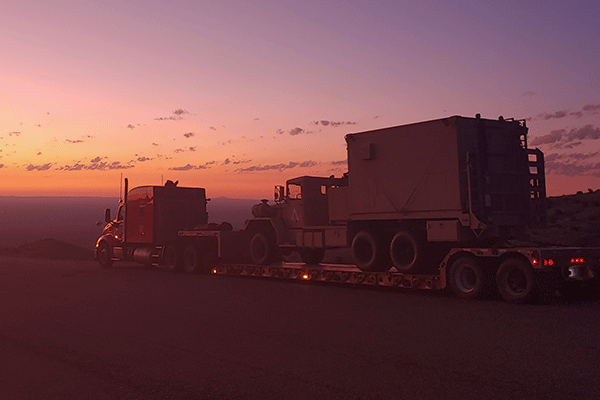Paper or plastic. . .
Sweet or salty. . .
iPhone or Android. . .
Step-deck or lowboy. . ?
Oh choices, we face them every day.
In the transportation industry, like literally everywhere else, you’ve got choices to make. And, boy oh boy, are there a lot of them.
“Which carrier should I use?”, “Is my freight too tall for a step-deck?”, “Is a lowboy the right choice for my freight?”
These, and questions like these, rattle around your brain and make the process of choosing a trailer for your freight feel quite stressful.
Here at ATS, we’ve been helping our customers make decisions about their freight for over 65 years. That said, we understand how difficult it can be to firmly grasp the intricacies of this industry especially without all of the information. It’s time we put an end to this.
Today, we’re here to offer you a helping hand in your struggle to decide whether a step-deck or lowboy trailer fits your needs best.
In this blog, we’ll break down the difference between step deck and lowboy trailers so that you can finally decide for yourself which is best for your freight.
Below, you’ll be given clear and concise information answering the questions of:
- What is a step-deck trailer?
- What is a step-deck trailer used for?
- What shouldn’t a step-deck trailer be used for?
- How does using a step-deck trailer impact your price?
- What is a lowboy trailer?
- What is a lowboy trailer used for?
- What shouldn’t a lowboy trailer be used for?
- How does using a lowboy trailer impact your price?
To read or not to read. . .
I’ll make this one easy for you . . . read.
What is a Step-Deck Trailer?
Step-deck trailers, also commonly referred to as “drop-deck” trailers, are a natural alternative to the traditional flatbed. These trailers, which typically measure either 48 or 53 feet in length, are an incredibly versatile equipment type.
Comprised of an upper deck and a close-to-the-ground rear section, most common step-deck trailers can haul loads measuring up to 10 feet, 2 inches in height before being considered over-dimensional.
Where flatbeds are typically 5 feet off the ground, step-deck trailers are much shorter, measuring 3 feet, 4 inches at their lowest point. In the 53 foot version, the lengths of the upper and lower decks of these trailers are 10 feet and 43 feet respectively, leaving plenty of room to haul many kinds of freight.
What is a Step Deck Trailer Used For?
In the transportation industry, we measure a truck and trailer’s legal capacity by subtracting the weight of the semi-tractor plus the weight of the empty trailer from 80,000 pounds.
The number we’re left with is the total amount of freight weight that a trailer can legally haul without over-dimensional permitting. Although this number varies from one trailer to another, the typical weight capacity of a step-deck trailer falls right around 46,000 pounds.
As such, these trailers are used to haul freight that falls at or near 46,000 pounds and below their 10 foot, 2-inch ceiling.
Although these trailers can be used to haul open deck freight interchangeably with a flatbed, such as construction materials (I-beams, concrete, lumber), they also have a specific use-case centered around hauling taller freight.
Products such as agriculture equipment, crated industrial machinery and other large goods are commonly transported using step-deck trailers.
Note: should you need it, step-decks also offer a deployable ramp for driving freight onto/off of their deck. This is especially convenient for those shippers/consignees without cranes or other riggers on-site for loading/unloading.

What Shouldn’t a Step-Deck Trailer Be Used For?
Step-deck trailers can only transport commodities that are shorter than 10 feet 2 inches in height before they become over-dimensional. For this reason, if you’re hoping to move freight that exceeds this height, consider using a more specialized equipment type.
Also — due to the open-air nature of these trailers — step decks provide limited protection from the elements, even when tarped. For any freight where protection during transit is a concern, a step-deck won’t fit your needs
How Does Using a Step-Deck Impact Your Price?
Using a step-deck, although slightly more specialized than the traditional flatbed, isn’t typically more expensive. As a result, using a step-deck trailer won’t impact your price in any significant way.
Factors such as the supply of trailers in your area, the urgency of your shipment and seasonality all play a far larger role in determining your price than jumping from a flatbed to a step-deck.
That said, if you have a commodity — such as lumber — that can be transported on either a step-deck or a flatbed, opening yourself up to using either trailer type will increase your pool of potential solutions.
In turn, this added bargaining power — as the supply of these services has doubled and your demand has stayed flat — may leave you paying less for a trailer than if you were only sourcing for flatbed capacity.
As such, if you find yourself with freight that could be transported on either a step-deck or flatbed trailer — work with your transportation provider to make this decision — allowing flexibility on which equipment type you use will save you the money you’d spend by locking yourself into one or the other.
Food for thought . . .What is a Lowboy Trailer?
Also known as double-drop, low-bed or float trailer, the lowboy trailer is far closer to the ground than any other trailer type — typically 24 inches above the pavement. This proximity to the ground is thanks to two drops that occur behind the gooseneck and before the rear wheels.
Because of the nature of these drops, the total length capacity offered by the lowboy trailer is limited to their well-space. This well-space typically measures between 25 and 30 feet in total length.
What the lowboy gives up in overall well-space, it makes up for in height capacity. And, the maximum legal height of any freight carried by a lowboy trailer can reach 11 feet, 6 inches — as long as the trailer is 24 inches above the ground or under.
What is a Lowboy Trailer Used For?

With a weight limit ranging between 40,000-80,000 pounds (depending on the number of axles) lowboy trailers are plenty capable of heavy hauls.
Couple this with their advanced height capacity, and the lowboy becomes the perfect solution for hauling large equipment such as excavators, crated machinery, large tractors and industrial equipment measuring less than or equal to 11 feet, 6 inches high.
When needed, the upper and rear decks of these trailers — which vary in height and typically measure between 6 and 10 feet long — can be used to haul any additional freight that doesn’t fit within their 25 to 30 feet of well-space.
What About Lowboy Removable Goosenecks (RGNs)?
In addition to the traditional lowboy, this double-drop equipment type is also offered with a removable gooseneck (RGN).
The front portion of these trailers (the gooseneck) can be removed from the remainder of the trailer’s body. Doing so creates a ramp that can be used to move self-propelled equipment onto and off of the trailer.
Simply drive your equipment onto the trailer before its departure, safely secure it and drive it off once you reach your destination. This removes the need to have cranes and forklifts on hand for the loading/unloading process.
These lowboy RGNs are used in a lot of the same ways as traditional lowboys. As such, they have the same weight and height restrictions as their counterparts.
Like the traditional lowboy, the amount of well-space needed is a prime factor in whether these trailers are used. Any time a load exceeds 30 feet in length, the space provided by the wells of these trailers becomes insufficient without expandable capabilities.
What Shouldn’t a Lowboy Trailer Be Used For?
Due to the specialized nature of these trailers, lowboys shouldn’t be used to transport freight that could be handled with a less complex setup as this may drive up the price you pay.
For example, if your freight doesn’t require the added height and weight capacities (3-axles +) of the lowboy trailer, consider a step-deck or flatbed instead.
How Does Using a Lowboy Impact Your Price?
Lowboy trailers — in particular lowboy RGNs — are a more specialized equipment type than your traditional step deck trailer.
As such, the drivers pulling these trailers must be more experienced in hauling larger freight and the processes that accompany doing so. Using these trailers correctly and securing the freight on their bed can, in some cases, be far more intricate than using other equipment types.
For this reason, you should expect to pay more money to move a commodity that requires a lowboy trailer rather than a step-deck.
Which Equipment Type is Best For Your Freight?
There are large discrepancies between the use cases for each of these trailers.
For example, if you need to move freight with an overall height greater than 10 feet, two inches, a step-deck simply won’t meet your needs. On the other hand, if your freight is less than 53 feet long and falls below 10 feet, 2 inches in height, a step-deck will be your most cost-effective option.
Use the comparison chart below, where we've compared the capabilities of the most common step-deck and lowboy trailers to pick the right trailer for your freight:
| Step Deck | Lowboy | |
| General Weight Capacity (2-axles) | 46,000 Pounds | 42,000 Pounds |
| Height Capacity | 10 feet, 2 inches | 11 feet, 6 inches |
| Maximum Deck Length | 53 feet | 53 feet |
| Distance Above Ground | 40 inches | 24 inches |
| More Expensive to Use (Generally) | ✓ | |
| Protection From the Elements | With Tarping | With Tarping |
| Use-case Versitility (Generally) | ✓ | |
| Drive-on/off Capable | With Ramp | With RGN |
Expand Your Industry Knowledge Further.
Now that you have a better understanding of how each of these trailers should be used, you’re ready to continue your freight transportation journey.
The more you understand the intricacies of this business, the better prepared you’ll be to get your freight moving safely and effectively.
To help you do this, you’ll also want to learn the differences between dry van and reefer trailers including when each should be used and how each of them impacts freight rates.
Also, download this trailer card for more in-depth insight into the different trailer types available in this industry.
Here at ATS we take pride in being true experts in the transportation industry. That said, please don’t hesitate to reach out with any questions or concerns you may have. We’re happy to assist you in any and every way we can.



